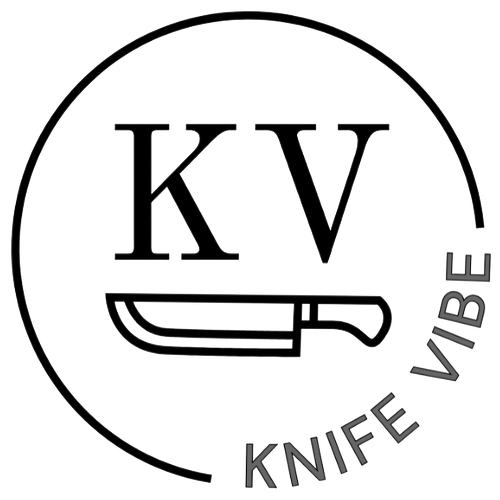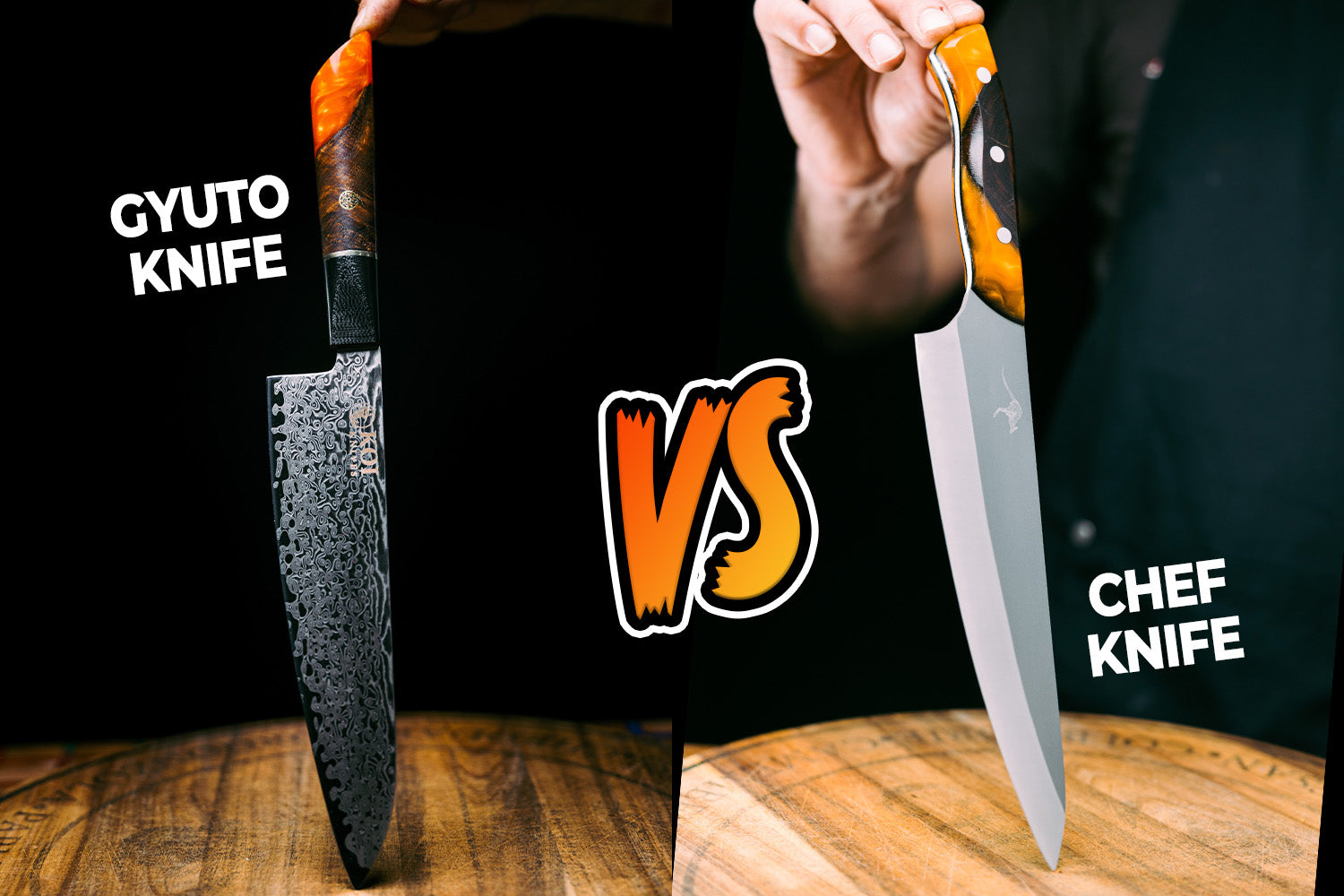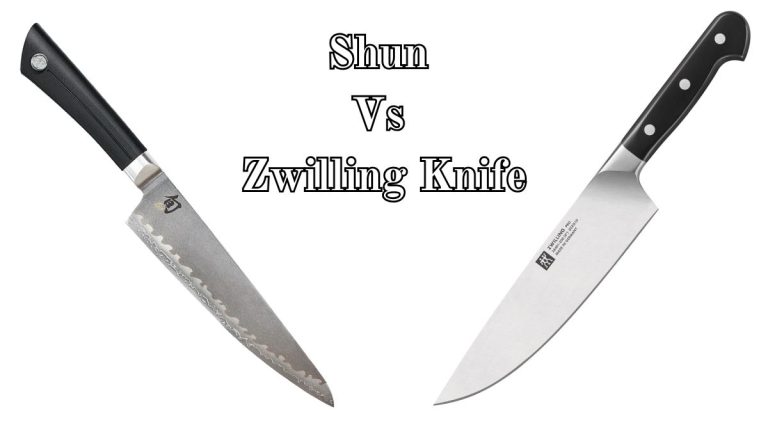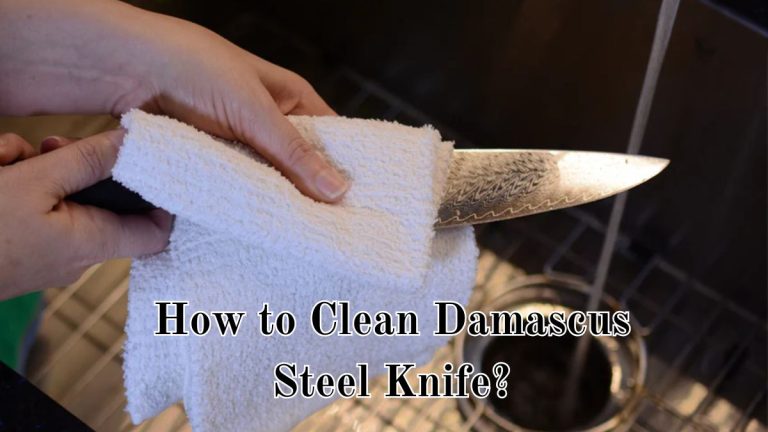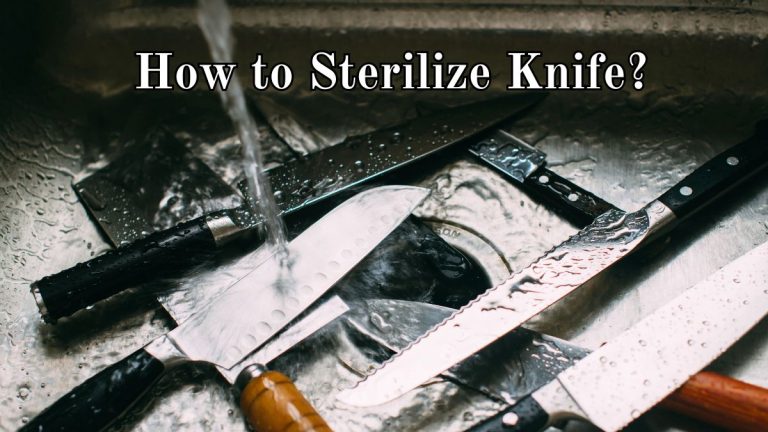Gyuto Knife Vs Chef Knife: Ultimate Battle of Kitchen Blades
Choosing the right kitchen knife can be tricky. Both Gyuto and Chef knives are popular options.
Understanding the differences between a Gyuto knife and a Chef knife can help you make an informed decision. Both knives serve as versatile tools in the kitchen, but they have distinct features and origins. The Gyuto knife hails from Japan, known for its thin blade and precision.
On the other hand, the Chef knife, often associated with Western cooking, boasts a broader blade suitable for heavier tasks. This comparison will guide you through the key aspects of each knife, helping you decide which one fits your cooking style better. Whether you’re a professional chef or a home cook, choosing the right knife can elevate your culinary experience.
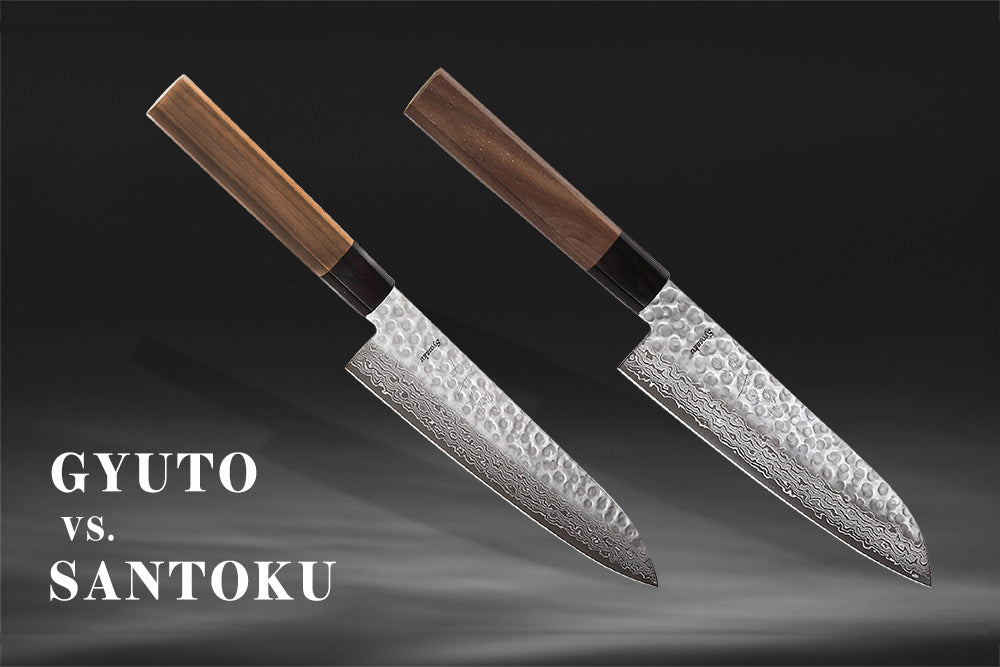
Credit: syosaku-japan.com
Gyuto Knife Basics
The Gyuto knife is a versatile Japanese kitchen tool. It has gained popularity worldwide. Known for its precision, it stands out in many kitchens. Understanding its basics helps appreciate its unique qualities.
Origin And History
The Gyuto knife has roots in Japan. Its name translates to “beef sword.” Originally, it was designed for cutting beef. Over time, its use expanded to other tasks. Today, it slices vegetables, fish, and more.
The knife’s history dates back to the 19th century. It evolved from Western chef knives. Japanese craftsmen adapted it to their needs. They combined Western and Japanese techniques. This fusion created the modern Gyuto knife.
Design And Features
Gyuto knives have distinct designs. They feature a thin blade. This blade tapers to a sharp point. The edge is slightly curved. It allows rocking motions for chopping.
Most Gyuto knives use high-carbon steel. This material holds a sharp edge longer. Some models use stainless steel. These resist rust and stains better. The handle is often made of wood. It provides a comfortable grip.
The blade length ranges from 8 to 12 inches. This variety suits different tasks. Chefs value the Gyuto for its balance. It feels natural and easy to control. These features make it a favorite in many kitchens.
Chef Knife Essentials
Chef knives are essential tools in any kitchen. They offer versatility and efficiency for a range of tasks. From chopping vegetables to slicing meat, a good chef knife can do it all. Knowing the essentials of a chef knife helps in making an informed choice. This section dives into the background and key characteristics of chef knives.
Background And Development
The chef knife has a rich history. Originating in Germany and France, it has become a staple in kitchens worldwide. German chef knives are known for their durability and strength. French chef knives are lighter and more precise. Both styles have influenced modern chef knife design.
Over time, the chef knife has evolved. Advances in technology and materials have improved their performance. Today, chef knives come in various sizes and shapes. Each designed to meet specific needs. Despite these changes, the core purpose remains the same: to be a versatile kitchen tool.
Key Characteristics
A chef knife typically has a broad blade. The blade is between 8 to 12 inches long. This length makes it suitable for many tasks. The blade is curved to allow a rocking motion while cutting. This design helps in chopping and dicing efficiently.
The handle of a chef knife is also important. It should provide a comfortable grip. Handles are made from various materials like wood, plastic, and metal. Each material has its own advantages. A good handle reduces hand fatigue during extended use.
Chef knives are often made from stainless steel. This material is strong and resistant to rust. Some high-end knives use carbon steel for better edge retention. Proper maintenance is crucial for keeping the blade sharp and effective.
Blade Materials
Choosing the right knife involves understanding its blade materials. The materials affect sharpness, durability, and maintenance. Both Gyuto and Chef knives use different steels. Let’s explore their types and how they impact performance.
Types Of Steel Used
Gyuto knives often use high-carbon steel. This steel type provides exceptional sharpness. It requires regular maintenance to prevent rust. Some Gyuto knives use stainless steel. This option offers lower maintenance but slightly less sharpness.
Chef knives commonly use stainless steel. It resists rust and corrosion. This makes it easier to care for. Some high-end Chef knives use high-carbon stainless steel. This combines sharpness and low maintenance.
Impact On Performance
High-carbon steel in Gyuto knives offers superior edge retention. This means the blade stays sharp longer. It allows for precise cuts. Yet, it needs regular sharpening and care.
Stainless steel in Chef knives provides durability. It requires less frequent sharpening. This makes it more user-friendly. High-carbon stainless steel offers a balance. It gives good edge retention and easy maintenance.
The choice of steel impacts how you use the knife. Consider your cutting style and maintenance preference. Both Gyuto and Chef knives have unique benefits. Understanding blade materials helps you choose the right one.

Credit: www.facebook.com
Sharpness And Maintenance
Sharpness and Maintenance are crucial factors to consider when comparing a Gyuto knife and a Chef knife. Both knives are popular in kitchens, but understanding their edge retention and sharpening techniques can help you make an informed decision.
Edge Retention
Edge retention refers to how long a knife stays sharp during use. A Gyuto knife, made from high-carbon steel, tends to have excellent edge retention. This means it stays sharper for a longer period compared to other knives.
On the other hand, a Chef knife, often made from stainless steel, may not hold its edge as long. Stainless steel is durable and resistant to rust, but it may require more frequent sharpening.
| Knife Type | Material | Edge Retention |
|---|---|---|
| Gyuto Knife | High-Carbon Steel | Excellent |
| Chef Knife | Stainless Steel | Moderate |
Sharpening Techniques
Sharpening techniques vary for both knives. For a Gyuto knife, using a whetstone is recommended. A whetstone allows for precise sharpening and helps maintain the blade’s sharpness. Follow these steps:
- Soak the whetstone in water for 10 minutes.
- Place the stone on a stable surface.
- Hold the knife at a 15-degree angle.
- Slide the blade across the stone in a sweeping motion.
- Repeat on the other side of the blade.
Chef knives can also be sharpened with a whetstone, but a knife sharpener is often used for convenience. The steps are similar:
- Choose the correct slot on the knife sharpener.
- Insert the blade and pull through slowly.
- Repeat until the blade is sharp.
Regular maintenance ensures your knives stay in top condition. Clean and dry them after each use, and store them properly to avoid damage.
Versatility In The Kitchen
Choosing the right knife can make your kitchen tasks easier. Both Gyuto and Chef knives have unique qualities. They offer different levels of versatility in the kitchen. Understanding their strengths and weaknesses can help you decide which one suits your needs.
Suitable Tasks
Gyuto knives are great for precise cutting. They excel in slicing vegetables, fruits, and meats. Their thin blade allows for fine cuts and detailed work. Gyuto knives are also good for fish and seafood preparation. They provide clean, smooth cuts without tearing.
Chef knives are known for their multipurpose use. They handle a wide range of kitchen tasks. Chopping, dicing, and mincing are easy with a Chef knife. Its robust blade can tackle tough vegetables and meats. A Chef knife can also crush garlic and ginger with ease.
Limitations
Gyuto knives may struggle with hard or thick items. The thin blade can bend or chip. They are not ideal for tasks like breaking bones or cutting through squash. Care is needed to avoid damaging the blade.
Chef knives can be too bulky for detailed work. They lack the finesse of Gyuto knives. Fine slicing and intricate cuts may be challenging. They might also feel heavy for some users during long tasks.

Credit: ubaahaus.co.uk
Ergonomics And Comfort
Choosing between a Gyuto knife and a chef knife can be challenging. Both knives offer unique benefits. Ergonomics and comfort are key factors in this decision. How a knife feels in your hand can impact your cooking experience. Let’s explore the handle design and user experience of each knife.
Handle Design
Gyuto knives typically feature a traditional Japanese handle. This handle, often made of wood, provides a light and balanced feel. It usually has a D-shape, fitting comfortably in your hand. The lightweight design reduces fatigue during extended use.
Chef knives usually come with Western-style handles. These handles are often heavier and made from synthetic materials or wood. They feature a full tang, which means the blade extends through the handle. This design offers more durability and a solid grip. Some chef knives have an ergonomic shape that fits naturally in your hand.
User Experience
Using a Gyuto knife can feel nimble and precise. Its lightweight handle and balanced design make it easier to control. Many users appreciate its comfort during long cooking sessions.
Chef knives provide a robust and secure grip. Their heavier handle can help with more demanding tasks. Users often find them reliable for various cutting techniques. The ergonomic handle design reduces strain and enhances comfort.
Both knives have their strengths. Your choice depends on your comfort and cooking style. Consider how each knife feels in your hand. The right fit can enhance your culinary experience.
Price And Value
Understanding the price and value of a knife is crucial. This helps in making an informed purchase. Let’s delve into the cost comparison and long-term investment of Gyuto and Chef knives.
Cost Comparison
Gyuto knives usually come at a higher price compared to standard Chef knives. The reason lies in their Japanese craftsmanship and premium materials. Below is a table showing the price range for both types:
| Knife Type | Price Range |
|---|---|
| Gyuto Knife | $100 – $300 |
| Chef Knife | $30 – $150 |
As seen, Gyuto knives are more expensive. But, they offer exceptional quality. Chef knives are more budget-friendly. They are suitable for basic kitchen tasks.
Long-term Investment
Investing in a Gyuto knife can be worthwhile in the long run. These knives are known for their durability and sharpness. They require less frequent sharpening. This means they can last many years if maintained properly.
On the other hand, Chef knives might need more frequent replacements. They often lose their edge faster. The initial lower cost can add up over time due to maintenance and replacements.
- Gyuto Knife:
- Higher initial cost
- Long-lasting
- Less frequent sharpening
- Chef Knife:
- Lower initial cost
- Frequent sharpening
- More replacements over time
Both knives offer unique value. Your choice depends on budget and long-term goals.
Frequently Asked Questions
What Is A Gyuto Knife Used For?
A Gyuto knife is versatile and used for slicing, dicing, and chopping. It’s excellent for both meat and vegetables.
How Is A Chef Knife Different?
A Chef knife is multi-purpose, used for slicing, chopping, and mincing. It has a broader blade than a Gyuto.
Which Knife Is Better For Beginners?
A Chef knife is better for beginners. It is more forgiving and versatile, making it easier to handle.
What Are The Blade Materials Used?
Gyuto knives often use high-carbon steel, offering sharpness and durability. Chef knives typically use stainless steel, which is rust-resistant.
Conclusion
Choosing between a Gyuto knife and a chef knife depends on your needs. Gyuto knives offer precision for delicate tasks. Chef knives provide versatility for various kitchen jobs. Both have unique strengths. Consider your cooking style. Think about what feels comfortable in your hand.
Try both if possible. Each knife can enhance your culinary experience. Ultimately, the best knife is the one you enjoy using. Happy cooking!
